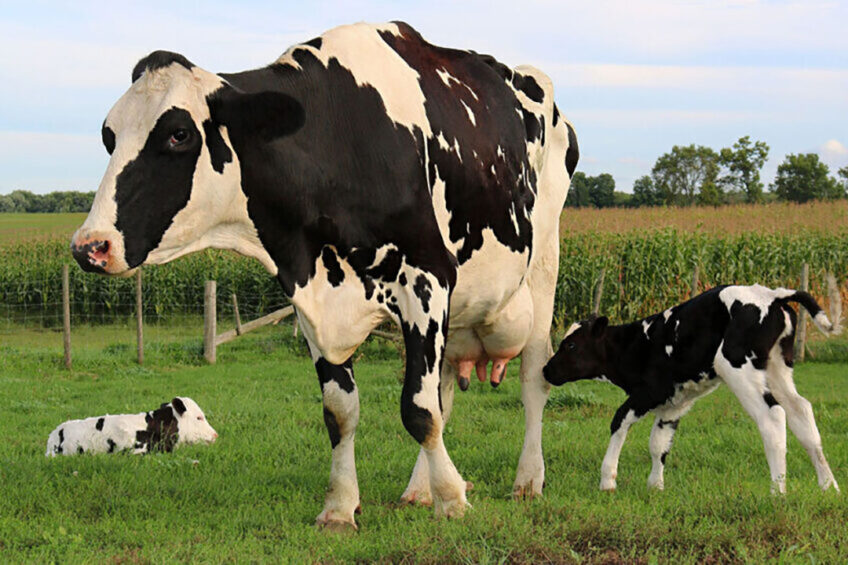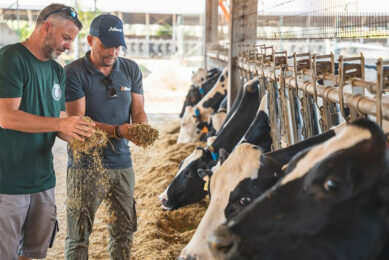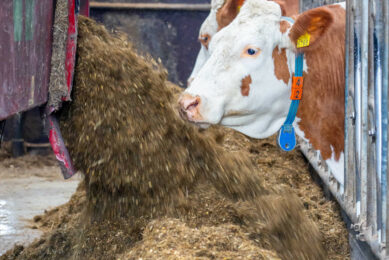Combining starch and sugar in lactating cow diets

Carbohydrates create up to 70% of the lactating cow’s diet and are fermented by microorganisms in the rumen to provide energy for bodily function, growth, maintenance, and production.
Corn is a common carbohydrate component of lactating cow diets which comprises of 70% starch. Bovine nutritionists recommend 23-30% dry matter of starch in lactating cow diets, due to negative impacts on neutral detergent fibre concentration and digestibility, ruminal fermentation, overall health, and production performance of dairy cattle. Therefore, it is essential to balance carbohydrates in lactating cow diets to improve their effects on ruminal function and milk production.
Studies suggest that soluble sugars such lactose and sucrose can partially replace starch to reduce detrimental effects of high concentrations of starch, to provide the energy requirements of the lactating cows, thus sustaining productivity and profitability.
Categorising carbohydrates
Carbohydrates comprise of monosaccharides, disaccharides, oligosaccharides, and polysaccharides.
- Monosaccharides are the simplest forms of sugar and the most basic units from which all carbohydrates are built.
- Disaccharides are combinations of 2 monosaccharides for example sucrose is made of fructose and glucose and lactose is made of glucose and galactose.
- Oligosaccharides are chains of 2-20 monomeric units of sugars.
- Polysaccharides are long chains of monomeric units of sugars such as cellulose and starch.
In addition, carbohydrates are categorised as structural and nonstructural. Structural carbohydrates such as cellulose and hemicellulose are fibrous components of the plant cell wall, while nonstructural carbohydrates such as starch and soluble sugars are found in the inside of the plant cell.
Starch
Starch is a straight chained polysaccharide used as a common source of energy. Feeding a high concentration of starch reduces dietary neutral detergent fibre concentration and digestibility, increases the production of volatile fatty acids and lactate, reduces ruminal pH and saliva production, lowers milk fat content, causes subacute ruminal acidosis and displaced abomasum, and reduces milk production.
Sugars
Sugars are soluble carbohydrates in the cell’s aqueous environment, in water or some in ethanol. Sugars are either fed directly in lactating cow diets for example sucrose and lactose or they can be incorporated through by-products such as molasses and whey. Sugars are fermented in rumen at a faster rate than starch and their inclusion in a lactating cow diet at 4-8% of dry matter has several beneficial effects.
Sucrose inclusion in diet maintains neutral detergent fibre digestibility, improves microbial protein growth and efficiency, decreases urinary excretion of urea nitrogen, and improves production and utilisation of nitrogen. In addition, sucrose in diet increases butyrate concentrations in the rumen which in turn increases growth and development of the ruminal epithelium and papillae, improves short chain fatty acid absorption and pH regulation, reduces the severity of ruminal acidosis, and increases dry matter intake and milk fat yield.
Lactose inclusion in diet causes a smaller decrease in ruminal pH compared to sucrose, increases butyrate proportion, and decreases acetate and branched chained fatty acids proportion, increases dry matter intake, alters ruminal fermentation, increases the fat percentage in milk composition, improves absorption capacity in the rumen, and maintain ruminal pH, nutrient digestibility, and production.
Important fact to consider
Considering all the benefits, starch can be partially replaced with sugar or by-products to maintain production. However, overfeeding sugar reduces performance; thus, it is recommended that total sugar concentration in the lactating cow diet should be around 5% (2.4% of sugar from added sugar, and 2.6% of sugar present in the basal diet).
A study by Brito and colleagues (2014) showed that corn meal or liquid molasses fed in combination with either soybean-sunflower meal mixes or flaxseed meal reduced yield of milk fat due to greater sugar inclusion (7.5%) than recommended level of 5%.
Concluding remarks
Combining starch and sugars in lactating cow diet is a viable option for producers to sustain health and production performance. However, it is important to include sugar at the recommended level of 5% to avoid detrimental effects. In addition, further research is required to investigate the impact of feeding sugars to calves and dairy cows in transition period to find out the potential benefits and to figure the extent they should be incorporated.
Join 13,000+ subscribers
Subscribe to our newsletter to stay updated about all the need-to-know content in the dairy sector, two times a week.










